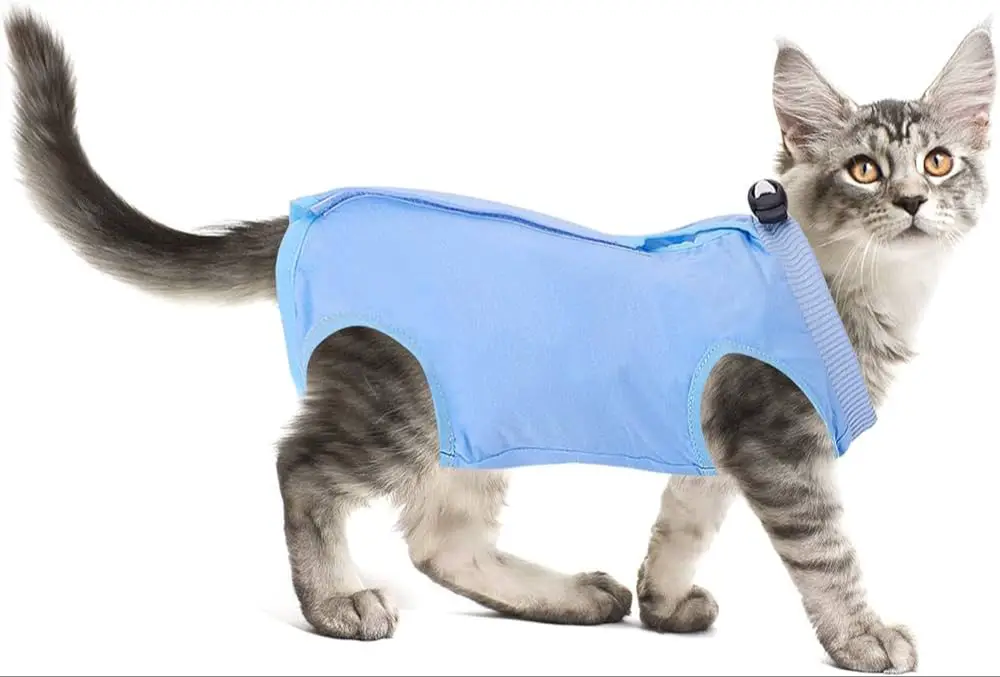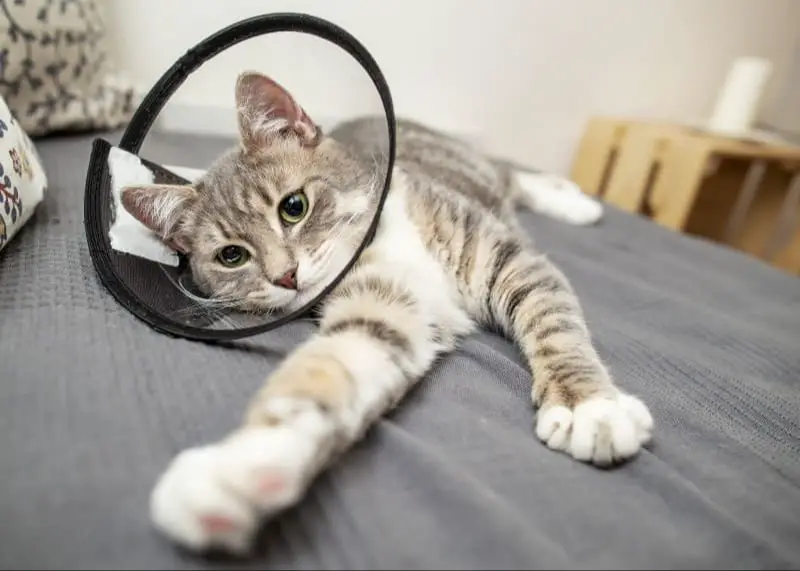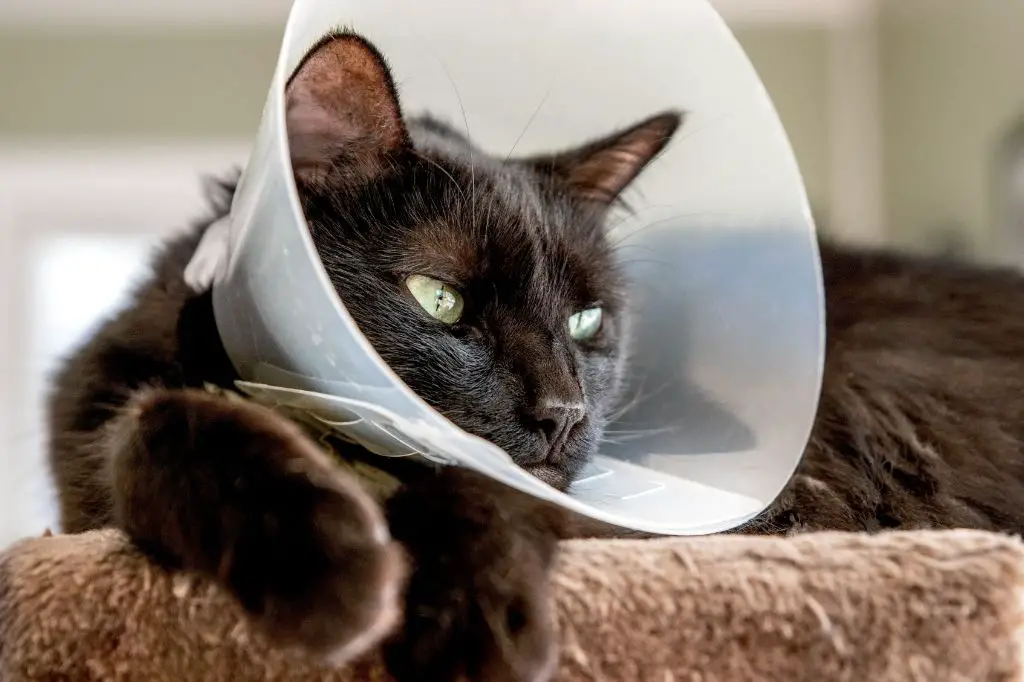What is a Cat Recovery Suit?
A cat recovery suit is a protective garment designed for cats to wear after medical procedures or injuries. The suit covers the cat’s torso and sometimes legs, providing protection and compression for incision sites or wounds while still allowing free movement and use of the litter box (Amazon, 2022).
The main purpose of a cat recovery suit is to prevent a cat from biting, licking, or scratching at surgical incisions or injuries. This helps prevent infections, dehiscence (reopening of a surgical wound), and removal of sutures or bandages. The gentle compression also promotes healing. Recovery suits are commonly used after spays/neuters, surgeries that require abdominal incisions, dental procedures, or even dermatological issues where scratching needs to be limited (Cuteness, 2023).

Unlike Elizabethan collars, which cats often resist or get stuck in, recovery suits allow cats to eat, drink, sleep, play, and use the litterbox normally. This improves quality of life during healing and reduces stress for both the cat and owner (Cuteness, 2023).
When are Cat Recovery Suits Used?
Cat recovery suits are commonly used after surgeries or medical procedures that require protecting wounds or incisions. The most common situations when a cat would need to wear a recovery suit include:
Spay or neuter surgery – To prevent licking, biting or scratching at the incision site while it heals. Recovery suits provide more coverage than alternatives like cones. [1]
Dental procedures – Covers the neck area to prevent irritation of the mouth and throat. [2]
Abscess draining or wound treatment – Protects wounds on the body from scratching or licking off medications/bandages. Allows air flow for healing.
Allergy-related hot spots – Prevents licking or biting irritated skin during healing and treatment.
Injuries like broken bones or stitches – Immobilizes and protects affected areas to prevent reinjury from activity.
After surgeries like lump removal – Protects incision sites anywhere on the body while providing full mobility.
How Do They Work?
Cat recovery suits are designed with certain features and materials that help protect injuries or surgical sites from further damage. According to RECOVERY SUIT® CAT, the suits are made of lightweight, breathable fabric that provides gentle compression around the torso. This helps restrict movement and prevent biting or scratching of the affected area.
The design covers the problem spots but leaves the head, limbs, and tail free. This allows the cat mobility to eat, drink, and use the litterbox while shielding injuries on the body, back, or belly. The fabric has Velcro closures along the belly, neck, and rear for a customized, secure fit.
According to The 7 Best Cat Recovery Suits to Help Your Kitty Heal, many suits also utilize bandage loops that can hold dressings, drains or post-op wraps in place. This protects external incisions or wounds while allowing them to be monitored and changed as needed.
Overall, the snug yet flexible fabric limits range of motion just enough to prevent a cat from aggravating injuries. The specialized design allows cats to engage in normal activities during recovery while shielding vulnerable areas.
Benefits
A cat recovery suit provides several important benefits for cats recovering from injury or surgery.[1] The main benefit is preventing the cat from interfering with wounds and incisions by biting, scratching, or excessively licking the area.[2] The protective coverage of the suit reduces the risk of wounds reopening or infections developing. Recovery suits can also help prevent the cat from removing sutures, bandages, or other medical devices.
Additionally, the suit can be used to securely hold dressings or cold compresses against the skin for therapeutic effects. For cats recovering from orthopedic surgery, a suit may restrict mobility to allow healing while preventing re-injury. The compression provided by the garment creates a sense of security and comfort for the cat during recovery. Suits are available with full or partial coverage to target specific areas needing protection.
By aiding in the healing process and preventing the cat from aggravating its condition, a recovery suit can shorten recovery time. This allows the cat to resume normal activity levels and quality of life more quickly after injury or surgery. The suit benefits both the cat’s health and the owner’s peace of mind during the vulnerable recovery period.
Considerations
There are some important factors to consider when selecting and using a cat recovery suit.
Make sure to choose the right size for your cat. The suit should be snug but not too tight. Measure your cat and compare to the sizing chart for the specific brand of suit you select. An ill-fitting suit can cause discomfort or allow your cat’s incision to still be exposed (According to Rover’s “The 7 Best Cat Recovery Suits to Help Your Kitty Heal After Surgery”).
Select a lightweight, breathable material like cotton or mesh for your cat’s comfort. Avoid plastic or vinyl suits that don’t allow airflow (As recommended by pet owners on the Ask Metafilter forum).
Look for a suit with velcro or snap closures that are easy to secure but also allow you to check the incision area. Zippers and complicated closures can be tricky with a struggling or unwilling cat (Based on feedback from vets cited in Rover’s article).
Monitor your cat closely when they are wearing the recovery suit. Ensure it is not causing them distress. And check that the incision area remains clean and infection-free (Per veterinarians on the Metafilter forums).
Use soft cotton trims around leg holes to prevent chafing. And opt for a lightweight collar built into the suit instead of a bulky cone (According to cat owners on Rover).
Allow for bathroom breaks by removing the suit. Avoid having your cat wear it 24/7. Follow any guidelines from your vet on duration and frequency of use (As recommended by vets on Ask Metafilter).
Putting On a Recovery Suit
Putting on a cat recovery suit properly is important to make sure your cat is comfortable and can heal. Here are the key steps according to Suitical (source):

- Insert your cat’s head through the opening.
- Followed by inserting one leg into the provided smaller leg opening and the other leg into the other leg opening.
- Secure the rear Velcro strips snug around your cat’s hindquarters.
- Secure the two front Velcro strips under your cat’s chest.
- Make sure the suit is snug but allows room for breathing comfortably.
- Check the seams around the neck, legs, and body to ensure no pinching.
- Monitor your cat at first to ensure the suit stays properly in place.
Be patient and calm when putting on the recovery suit, as your cat may resist at first. With practice, most cats get accustomed to wearing the suit. Ensure a proper fit for safety and comfort.
Caring for a Cat in a Recovery Suit
Caring for a cat wearing a recovery suit requires some extra attention and care. Here are some tips for caring for a cat in a suit after surgery or injury:
Check the incision site regularly. Look for signs of redness, swelling or discharge, which could indicate an infection. Clean the area gently if needed (VCA Animal Hospitals).

Watch closely to ensure your cat does not chew or lick the incision site. The suit is designed to prevent this, but some persistent cats may still try to access the area (Preventive Vet).
Make sure the suit is properly fastened and positioned so your cat cannot wiggle out of it. Check for any loose straps or openings. Refasten the suit if needed (Cats.org).
Follow all post-op care instructions from your vet, including administering any medications and restricting activity. Confine your cat when you cannot monitor them (Preventive Vet).
Give your cat ample soft bedding and warm resting spots where they can comfortably relax while healing (Cats.org).
Entice your cat to eat and drink normally by warming food to enhance smells and using shallow, wide bowls. Canned foods may be more appealing (VCA Animal Hospitals).
Provide extra playtime and affection. Your cat cannot groom itself while in the suit, so gently brush and pet them to provide comfort (Cats.org).
Monitor for signs of stress like decreased appetite or crying. Talk calmly, use pheromone diffusers and give medication if prescribed to ease anxiety (Preventive Vet).
Potential Problems
While recovery suits provide an alternative to the cone collar for cats, there are some potential issues to watch out for when using them:
Discomfort – The suit may cause discomfort, anxiety, or agitation in some cats, leading to resistance or strange behavior. Make sure the suit fits properly and monitor your cat’s reaction (Source).
Restricted movement – The suit may make it difficult for the cat to move around, use the litter box, jump up on furniture, etc. Look for signs your cat is struggling with basic activities (Source).
Pressure sores – Ill-fitting suits can cause chafing, rubbing, or sores. Check for redness, irritation, or wounds where the suit contacts the skin.
Overheating – Cats can overheat in the suits, so monitor temperature and ensure adequate airflow. Consider a partial suit if overheating is an issue.
Chewing/scratching – Cats may try to bite or scratch the suit off. Use proper fit, distraction, supervision, or try an inflatable collar if this becomes a problem.
Hindered recovery – If the suit causes added stress or restricts movement too much, it could slow the healing process. Work with your vet if problems arise.
Alternatives

While recovery suits can be very helpful for cats recovering from surgery or injuries, there are some other options besides a full body suit that pet owners can consider:
An inflatable donut collar is a cushioned collar that prevents a cat from biting their incision site or irritating their injury. It allows for more visibility and mobility than a traditional cone.
Some pet owners make their own DIY collars out of cardboard, fun noodles, or other household materials. These soft, lightweight barriers can work for minor procedures.
Using a onesie or baby clothes is another alternative to a full recovery suit. This protects the incision area while allowing for some mobility.
In some cases, cats may not need any protective covering if they are calm, non-destructive, and can avoid irritating the affected area on their own.
Pet owners should consult with their veterinarian to determine the best option for their cat’s specific situation and recovery needs.
Key Takeaways
A cat recovery suit is a lightweight suit that prevents a cat from licking, biting or scratching wounds on their body while recovering from surgery or injury. The benefits of a recovery suit include protecting wounds, preventing infections, reducing stress, and enabling mobility. Some key points to remember:
- Recovery suits allow wounds to heal while enabling mobility so muscles don’t atrophy.
- Cats should be monitored while in a recovery suit to ensure it stays in place and no chafing occurs.
- Alternatives like e-collars or bandages may work but have their own considerations.
- Proper fitting is important, suits should not be too tight or loose. Elastic openings allow bathroom functions.
- The suit limits self-trauma and so promotes faster healing with less complications.
Following veterinary instructions for use and properly caring for a cat in a recovery suit can promote healing and improve recovery time after medical procedures or injuries.
